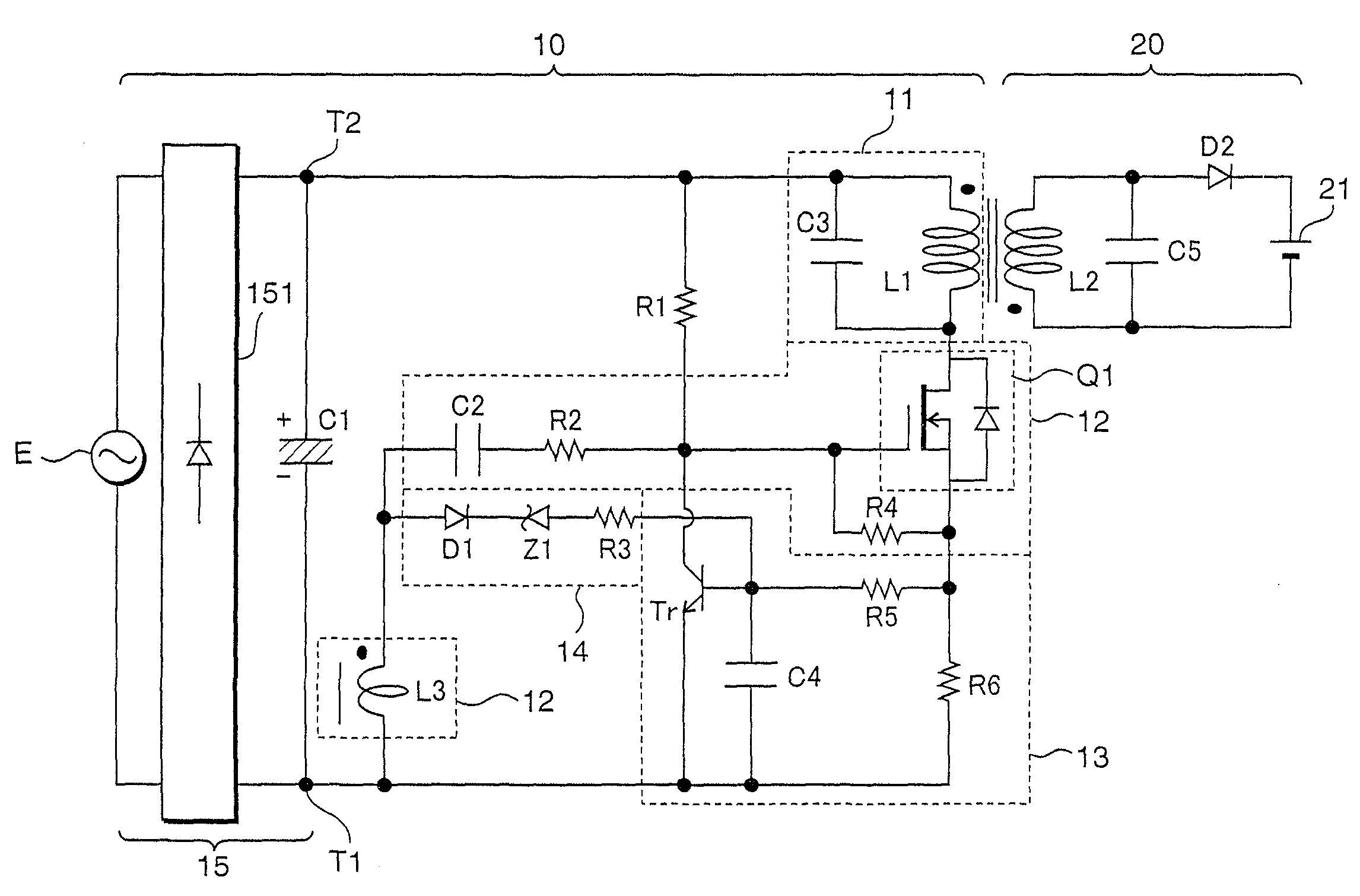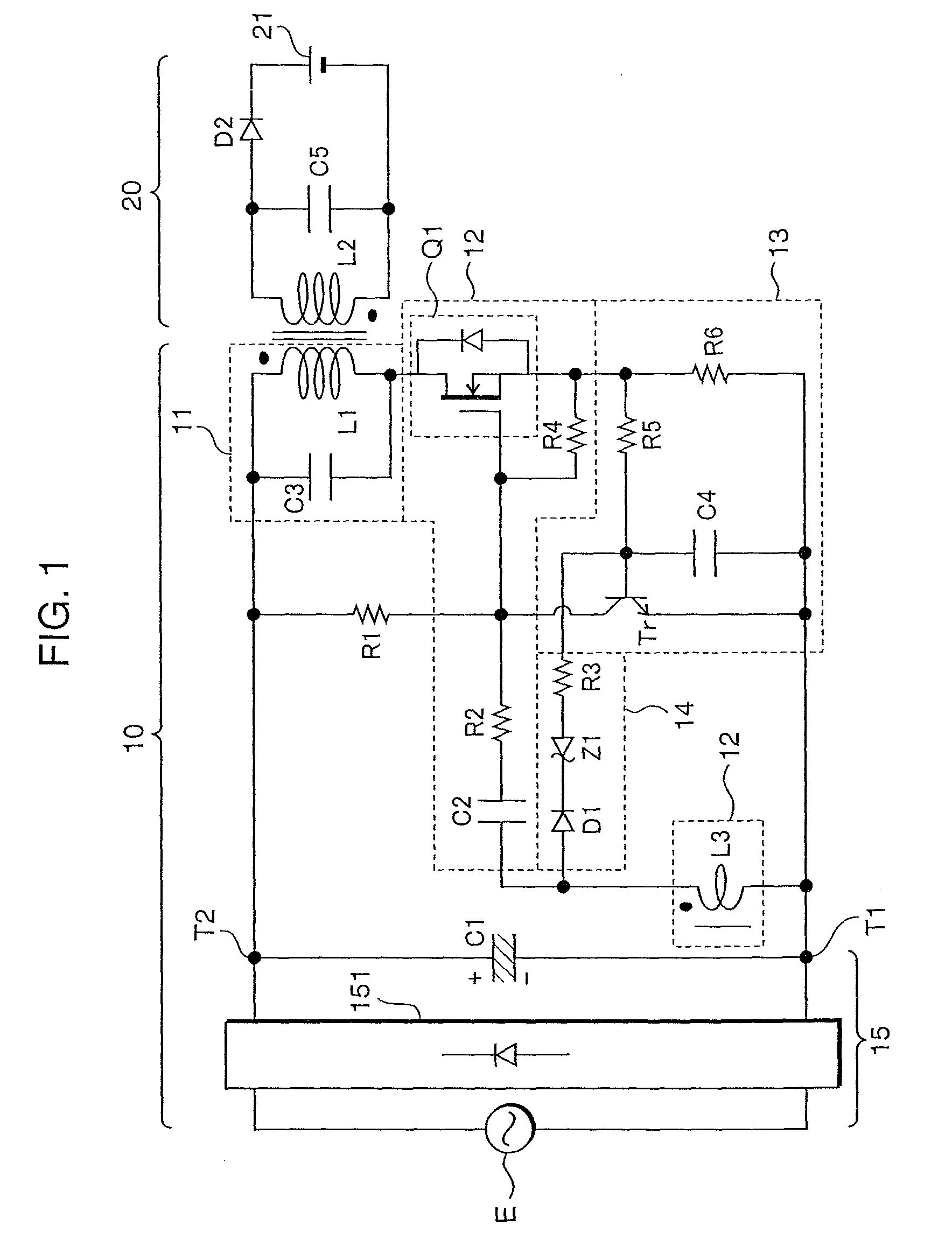Power supply circuit and power supply system
a power supply circuit and self-oscillation technology, applied in the direction of electric variable regulation, process and machine control, instruments, etc., can solve the problems of increasing power loss, increasing noise, and excessive draining to source voltage of fetb>1/b>, so as to reduce the energy stored in the resonance section, the effect of quick turning off the first switching element and on-period of the first switching elemen
- Summary
- Abstract
- Description
- Claims
- Application Information
AI Technical Summary
Benefits of technology
Problems solved by technology
Method used
Image
Examples
embodiment 1
[0034]FIG. 1 shows a circuit diagram of the power supply system according to Embodiment 1 of the present invention. The power supply system comprises a power supply circuit 10 and a load device 20. The power supply circuit 10 comprises a resonance section 11, an oscillation section 12, a turn-off section 13, a charging section 14 (first charging section), and a power supply section 15.
[0035]The resonance section 11 comprises a resonance coil L1 and a resonance capacitor C3, which are connected in parallel, and supplies power to the load device.
[0036]The resonance section 12 comprises a feedback coil L3, a capacitor C2, a resistor R2, and a transistor Q1 (first switching element), and a resistor R4, and causes the resonance section 11 to self oscillate. The feedback coil L3 is magnetically coupled with the resonance coil L1 so that the gate side terminal of the transistor Q1 has positive polarity. Hereafter, the gate side terminal of the transistor Q1 of the feedback coil L3 is refer...
embodiment 2
[0061]Next, the power supply system according to Embodiment 2 of the present invention will be described. FIG. 4 shows a circuit diagram of the power supply system according to Embodiment 2 of the present invention. In is noted that in FIG. 4, like parts of those of Embodiment 1 are given like reference characters and the description thereof will be omitted. The power supply system according to Embodiment 2 is characterized in that a resistor R7 is connected between the positive electrode T2 and the base of the turn-off transistor Tr.
[0062]Since voltage inputted from the commercial power supply E will cause a current to flow in the turn-off capacitor C4 via the resistor R7, a partial voltage between the resistor R7 and the combined resistor of resistors R5 and R6 is always outputted to the turn-off capacitor C4. Accordingly, as the voltage of the commercial power supply E increases, the voltage outputted to the turn-off capacitor C4 will increase, thus enabling that the on-period of...
embodiment 3
[0065]Next, the power supply system according to Embodiment 3 of the present invention will be described. FIG. 5 shows a circuit diagram of the power supply system according to Embodiment 3 of the present invention. In is noted that in FIG. 5, like parts of those of Embodiments 1 and 2 are given like reference characters and the description thereof will be omitted. The power supply system according to Embodiment 3 is characterized in that a smoothing section 16 is connected in parallel to the charging section 14 in the power supply system of Embodiment 1. The smoothing section 16 comprises a diode D3, a capacitor C7, and a resistor R8. The diode D3 is connected at its anode to the positive terminal of the feedback coil L3 and at its cathode to the base of the turn-off transistor Tr via the resistor R8 and to the negative electrode T1 via the capacitor C7.
[0066]The smoothing section 16 performs the smoothing of the voltage of the feedback coil L3 to generate a voltage corresponding t...
PUM
 Login to View More
Login to View More Abstract
Description
Claims
Application Information
 Login to View More
Login to View More - R&D
- Intellectual Property
- Life Sciences
- Materials
- Tech Scout
- Unparalleled Data Quality
- Higher Quality Content
- 60% Fewer Hallucinations
Browse by: Latest US Patents, China's latest patents, Technical Efficacy Thesaurus, Application Domain, Technology Topic, Popular Technical Reports.
© 2025 PatSnap. All rights reserved.Legal|Privacy policy|Modern Slavery Act Transparency Statement|Sitemap|About US| Contact US: help@patsnap.com



